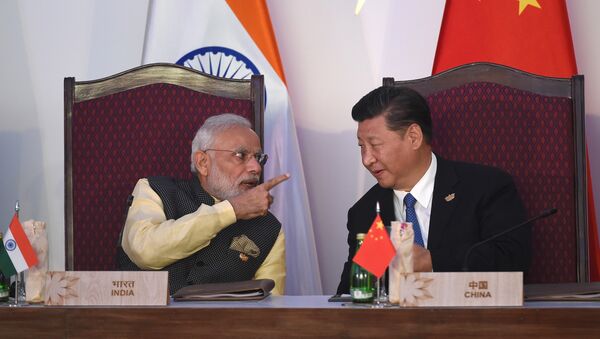In the background of the ongoing global trade battle and the possible ill-effects of the sanction diplomacy, Sputnik talked to Dr. Swaran Singh, Professor and Chair, Centre for International Politics, Organization and Disarmament, Jawaharlal Nehru University, Delhi to understand the ongoing developments and its repercussions. Experts from the interview:
Sputnik: Of late, India and China have been warming up to one other? With a war in its mutual legacy and the recent Doklam standoff last year, how do you see this thaw in the relations?
For an observer, this change may appear substantive in the backdrop of the ten-week long military standoff at Doklam last year. This is also suspected to have accelerated following President Trump's trade war with Beijing though that could at best be tactical with only limited bandwidth to transform China-India ties.
READ MORE: China Unveils New Animal Feed Rules to Reduce Soybean Imports Amid Trade War
Sputnik: Do you think that America's policy on trade and the diplomacy of sanctions had a role to play in China's overtures with India?
Swaran Singh: Yes, Trump's whimsical policies against one and all may have contributed to China and India coming closer yet rise of China and its expanding footprint under its Belt and Road Initiative (BRI) has surely contributed to this shift.
China has also made amends in redefining BRI from once being its unilateral initiative to emphasizing multilateralism and consultations to now proposing bilateralism of ‘two-plus-one' model of China coopting with major economies like India to explore joint projects in third countries. This has had its appeal in New Delhi which has also seen its friends like Russia, Iran, Afghanistan, drifting towards joining BRI.
Swaran Singh: Last week China-Japan had a currency swap agreement for $30 billion and this week India and Japan signed a similar currency swap agreement for $75 billion.
Hopefully, this could open possibilities of yuan-rupee swap in coming times. This is supposed to address their over-dependence on using US dollar as the currency for transactions which had become an issue in the face of India's shrinking foreign exchange reserves.
READ MORE: India Welcomes Improvement of Ties Between Japan, China — Foreign Ministry
Sputnik: While India pursues its neighborhood policy and Asian cooperation aggressively, it still struggles with rising trade deficit. Do you see a paradox in this?
Swaran Singh: India's shopping and enduring trade-deficit which reached from $52 billion to $85 billion for 2017 has defied all initiatives and out-of-box thinking like inviting China's investment into India's manufacturing to make it competitive. Indeed last four years have also seen India's trade deficit with Japan shooting up from $2.7 billion to $5.9 billion as their already tiny trade shrunk from $16.8 billion to $13.5 billion. This means there is an urgent need to make India's exports competitive. That is the only way to address this trade deficit though several other structural factors of regional and global dynamics also count in making this not so easy.
The views and opinions expressed by the Speaker do not necessarily reflect those of Sputnik.



